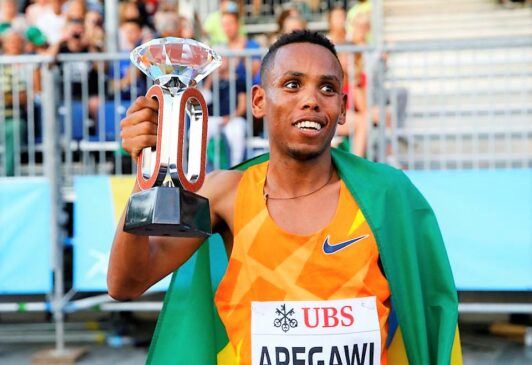Drifting in the wilderness: A review of 2016 in Ethiopian Football
By Zecharias Zelalem –

January 2017. We are days away from the start of the 2017 African Cup of Nations set to kick off in Gabon. The continental footballing program has been amassed with warm-up fixtures being organized by the federations of the sixteen national teams that will take part in the 2017 AFCON. But numerous African sides who won’t be in Gabon are also active in friendly competition, looking to capitalize on a chance to build towards the future and iron out the kinks of their penetrated armor that would result in their failure to qualify for the showpiece event in Gabon.
The Ethiopian national team, colloquially dubbed the Walyas, is among neither the former, nor the latter. Ethiopia, winners of the 1962 AFCON title and qualifiers for the 2013 event after a 31 year absence, are among the downtrodden or financially bedridden sides which have decided to refrain from mobilizing the national team. The likes of Eritrea, Somalia and Djibouti are among this class of teams. Thanks to a rather dismal 2016 showing in which the senior national team registered disappointing results, the Walyas failed to reach the AFCON. And in continuing with a ludicrous policy that has done its part to hinder national team progress, the Ethiopian Football Federation has decided friendly matches with other national sides weren’t necessary, hence the idle status of the country’s football, no fixtures, no national team coach, drifting in the wilderness.
Unlike in previous years, Ethiopian football fans for the most part didn’t have high expectations heading into 2016. After the euphoria of the Sewnet Bishaw era that saw the Walyas rewrite history and accomplish so much between 2012 and 2014, the appointment of an absolute nobody in Portuguese national Mariano Barreto as manager resulted in Ethiopian football being absolutely shot back to earth in 2014. So the pressure wouldn’t nearly be as high on his successor, former national team player Yohannes Sahle. Nevertheless, in 2015 the former Dedebit head coach steered the Walyas past the qualifying phase for the 2016 CHAN tournament and finished a respectable third place in that year’s CECAFA Challenge Cup hosted in Ethiopia. Sandwiched in between was a disappointing elimination from 2018 World Cup contention in the CAF qualifying second round at the hands of Congo Brazzaville.
The year started with a trip to Rwanda for the 2016 CHAN tournament on the horizon. Barely a week before their first group stage game, Ethiopia’s selection of home based players played Niger to a 1-1 at Addis Ababa Stadium in preparation for the competition. Looking back on it now, the events of that day could have served as an omen of what would come. Prior to kickoff, with fans in the stadium standing and both teams lined up to hear their national anthems, nothing. Twenty seconds passed with no music coming from the stadium speakers as people curiously looked up towards the booth housing the audio team. They sheepishly announced that the CD for the national anthems was “lost,” to a chorus of boos.
The game saw Coach Yohannes Sahle start with recalled veteran Adama Kenema striker Tafesse Tesfaye, in national team colours for the first time in six years. CECAFA Cup recruit Yared Bayeh played in a team that was missing a host of key players. Dawit Fekadu, Salahdin Bargecho and goalkeeper Tariku Getnet were all ruled out of the tournament. Throughout 2015, Coach Yohannes had experimented with dozens of players in every position and hadn’t settled on a regular set of players. So the half baked squad wracked with injuries and low on team chemistry looked far from convincing ahead of their trip to Rwanda. The scarcity of strikers was especially worrying, as the team managed to score an equalizer on an 89th minute penalty by Gatoch Panom, prior to which they rarely looked threatening.
The team would unravel in Rwanda. Playing against DR Congo, the team that would go on to be the 2016 CHAN champions, the Walyas caved in. Uncoordinated, unfamiliar with their teammates due to the coach’s constant switching of squad members, Ethiopia fell to a 3-0 defeat in their first game. Expectations were low ahead of the tournament. Coach Yohannes himself had said that the team’s realistic aim was to improve on their 2014 CHAN performance, in which they finished bottom of their group without a goal or a point to their name. Now it seemed to be all about exiting the group stage with at least a shred of their dignity intact.
Ethiopia would earn her first point in CHAN competition history when the Walyas played to a hard fought 1-1 draw against Cameroon. The game saw the likes of Aschalew Tamene, Seyoum Tesfaye and Gatoch Panom marshal things at the back and in the midfield for the Ethiopians, but goals weren’t forthcoming. They needed results elsewhere to go their way and a barrage of goals against Angola to stand a chance of progression, but a two one loss ended their aspirations. Seyoum Tesfaye slammed one past the keeper to score Ethiopia’s first ever goal in CHAN competition and avoid going scoreless for the second straight competition. Ethiopia finished bottom with a single point and a single goal. In that sense, Coach Yohannes may have achieved what he set out to achieve at a tournament in which his tactical ineptitude was exposed and his starting lineup selections left fans scratching their heads. Tafesse Tesfaye, way past his peak and a much slower, less mobile version of the player who was a scoring machine back in his heyday for Ethiopian Coffee FC was given ample time on the grand stage to show he was out of it. The teenaged dribbling sensation Binyam Belay of Commercial Bank of Ethiopia FC, who had more than proven his worth at the CECAFA tourney a month earlier, was a fringe player who was given no serious time to shine. Fans called for Yohannes Sahle to be sacked, but the gaffer remained bullish when asked, stating he wouldn’t step down. He blamed the team’s poor performance on a number of factors including injuries, biased refereeing and the power outage at the stadium that had halted the Cameroon game for some time. Coach Yohannes Sahle had made a name for himself with his stubborn refusal to take responsibility for the team’s poor performances and his constant shifting the blame elsewhere.
While the Walyas were struggling in Rwanda, Ethiopia saw the country’s U-17 women’s national team play for the first time. On the day the senior men’s team drew Niger in a friendly, Ethiopia’s girls played the away leg of their 2016 U-17 World Cup qualifying tie against Cameroon, losing 2-1, a respectable result that left many believing that the away goal, combined with the local support would buoy the girls into defeating Cameroon on aggregate in a couple weeks’ time.

The second leg was scheduled for January 24th at Addis Ababa Stadium. It was quite a spectacle. A surprisingly large turnout of fans came out to watch the U-17 girls’ team play their first ever home game. But it was quite evident that there had been no U-17 team prior to this two legged playoff. The team led by Coach Asrat Abate, struggled to play in oversized jerseys that seemed to drape over some of the smaller girls like night gowns. It appeared that the Ethiopian football federation simply allocated the team equipment and apparel used by the senior women’s team. Nevertheless, the younger girls sent the crowd into frenzy, racing out into a two goal lead through Melat Demeke, who scored on a delightful chip and Yemisrach Lakew. Leading 3-2 on aggregate, the girls sat back and tried to defend until the final whistle, but Cameroon scored an away goal that would take the game to penalties. The Ethiopian girls, under immense pressure unlike any they had faced before, were visibly nervous and struggled to keep their composure. At one point, with no one volunteering to take penalties, the captain had to force some of the girls to go and take spot kicks. Cameroon ended up winning 4-3 on penalties. The Ethiopian girls, representing their country for the first time and eager to impress the home crowd played their hearts out. The heartbreaking defeat left them crestfallen, sobbing on the pitch. Fans tried their best to console them, cheering and clapping them off the pitch.
In the aftermath of the Ethiopian women U-17 team’s elimination, Coach Asrat Abate told reporters at a press conference that he was proud of his girls, and that he alone was responsible for his team’s exit. It was a real breath of fresh air for Ethiopian football fans, accustomed to Coach Yohannes Sahle’s refusal to accept blame for his team’s woes. Coach Asrat’s demeanor garnered him praise despite his tactic of sitting back and defending a lead backfiring on him. Alas, the defeat was sadder for more reasons than one. Just how under-prioritized that U-17 team women’s team is was especially evident when the Ethiopian football federation didn’t bother to equip the team in kits that actually fit the players. It was quite evident that the journey over, the budding talented team of the country’s ambitious football loving girls, would be disbanded.
As the U-17 women’s team disappeared into obscurity, focus went back to the Walyas, who were now set to travel to Algeria and face the Desert Foxes on March 25th in 2017 AFCON qualifying action. Ethiopia had four points from two games defeating Lesotho 2-1 the previous summer before drawing Seychelles 1-1. Nobody expected them to put up much of a fight against the team that pushed Germany to the brink at the 2014 World Cup. Widely believed to be the strongest team on the continent, “Les Fennecs” sought to consolidate their position atop the pack.
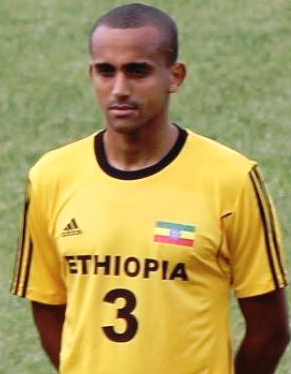 Ethiopia didn’t do themselves any favours, making an extremely difficult task even harder. Still without key center back Salahdin Bargecho, his namesake striker Salahdin Said ruled himself out citing unpreparedness. But the Walyas could have used the services of highly experienced Sweden based defender Walid Atta. Despite the latter’s willingness to travel with the team, the Ethiopian football federation were unable to contact Walid. Instead of contacting his Swedish Allsvenskan club side Östersunds FK as is custom, a fax was sent to Walid’s previous club, Turkish side Gençlerbirliği, despite his severing ties with that team, some six months or so earlier. Walid’s departure from Turkey and subsequent signing for Östersunds FK had made sporting headlines in Ethiopia. It was the talk of Ethiopian football fans at the time, and a mere Google search for Walid would have uncovered his return to Scandinavia. But apparently nobody at the Ethiopian football federation was aware of this, despite the fact that football federations’ are normally tasked with tracking the progress of their players. This callous blunder would come to cost them dearly. Despite Walid’s repeated statements to Ethiopian sporting media outlets, declaring he was fit and raring to go for Ethiopia, he wouldn’t be selected for the Algeria trip.
Ethiopia didn’t do themselves any favours, making an extremely difficult task even harder. Still without key center back Salahdin Bargecho, his namesake striker Salahdin Said ruled himself out citing unpreparedness. But the Walyas could have used the services of highly experienced Sweden based defender Walid Atta. Despite the latter’s willingness to travel with the team, the Ethiopian football federation were unable to contact Walid. Instead of contacting his Swedish Allsvenskan club side Östersunds FK as is custom, a fax was sent to Walid’s previous club, Turkish side Gençlerbirliği, despite his severing ties with that team, some six months or so earlier. Walid’s departure from Turkey and subsequent signing for Östersunds FK had made sporting headlines in Ethiopia. It was the talk of Ethiopian football fans at the time, and a mere Google search for Walid would have uncovered his return to Scandinavia. But apparently nobody at the Ethiopian football federation was aware of this, despite the fact that football federations’ are normally tasked with tracking the progress of their players. This callous blunder would come to cost them dearly. Despite Walid’s repeated statements to Ethiopian sporting media outlets, declaring he was fit and raring to go for Ethiopia, he wouldn’t be selected for the Algeria trip.
As if the injuries weren’t bad enough, Coach Yohannes Sahle’s hard-headedness meant that he would rule out a host of players from national team selection due to their having fallen out with him. Egypt based Omod Okori and then Defence Force midfielder Firew Solomon both lashed out at the coach on radio shows, permanently sealing their exiles, while Sudan based Addis Hintsa wasn’t even considered, after having clashed with Coach Yohannes years earlier when the duo were at Dedebit as a player and coach respectively.
The injuries, the coach feuding with a number of individuals, the lack of team cohesion, the extremely lengthy and tiring route via Europe chosen to travel to Algeria and the absence of Europe based Walid Atta meant that the country’s footballing bureaucracy had already shot the team in the foot before the first whistle blast at Blida Stadium.
 Still, the total on pitch meltdown the Walyas suffered wasn’t anticipated. The Algerians hit Ethiopia for SEVEN, while Getaneh Kebede scored a consolation goal. Algeria or not, the 7-1 drubbing was the ultimate on field humiliation that marked Coach Yohannes Sahle as a dead man walking from then on.
Still, the total on pitch meltdown the Walyas suffered wasn’t anticipated. The Algerians hit Ethiopia for SEVEN, while Getaneh Kebede scored a consolation goal. Algeria or not, the 7-1 drubbing was the ultimate on field humiliation that marked Coach Yohannes Sahle as a dead man walking from then on.
With national pride stung and the belief that there was any hope for reaching the AFCON all but extinguished, the second leg of the Ethiopia women’s national team tie against their Algerian counterparts took on a whole new importance.
The road to Cameroon, where the 2016 Women’s AFCON would be hosted started with a much more respectable 1-0 defeat away to Algeria for “Lucy.” The second leg would be played three weeks later, only a day after the Algeria’s men dished out an absolute battering to the Walyas. In the second leg at Addis Stadium packed with fans desperate for consolation and revenge, Ethiopia took the lead just past the half hour mark through Loza Abera, but with barely five minutes on the clock, Algeria scored the equalizer that would give them the aggregate win and eliminate Lucy from contending the 2016 AFWCOM tournament. Another heartbreaking late collapse robbed Ethiopian women of a result and a chance of appearing at a major tournament.
Before Ethiopian football fans even had time to process the double whammy handed out to their male and female national teams. They faced the prospects of seeing their Walyas receive another humbling by the same opponent at home as the second leg was scheduled a mere four days later.
The game would see the Walyas put on an absolute show at home. It appears the extremely low expectations and the desperation to restore their pride was enough to see them match the Algerians in every corner of the pitch. The players, who were outplayed and toyed with a mere couple of days ago, came to life at Addis Ababa stadium. The likes of Tadele Mengesha and Shemeles Bekele were a joy to watch, creative, quick and dangerous in the final third. Gatoch Panom dominated the midfield, while draft in left back Suleiman Mohammed, given the assignment of watching Leicester City star Riyadh Mahrez, did so admirably as the Algerians struggled to put passes together. Getaneh Kebede would score a brace, making it three goals in both games against Algeria for him, while Dawit Fekadu pounced on a fumbled ball to score what may have been the winner, had another stand in player, Anteneh Tesfaye not concede a foul in the dying minutes that would gift Algeria a penalty and a share of the points with a 3-3 scoreline. The team that had been completely dismantled and shamed four days earlier put on a performance of the ages.
It wouldn’t be enough for Yohannes Sahle.
As the league resumed, rumours were rife that Coach Yohannes Sahle, while applying for the post of Ethiopian national team manager, may have lied about his coaching credentials. He had always claimed to be a CAF certified instructor, a member of the continent’s panel of expert coaches.
Upon request, CAF faxed a list of Ethiopian certified CAF instructors to the Ethiopian football federation. Abraham Teklehaimanot, Abraham Mebrahtu, Anteneh Eshete, Mekonnen Kuru, Sewnet Bishaw and Getachew Abebe were all listed as having completed the mandatory courses needed to obtain a CAF instructor’s certificate. No mention of anyone named Yohannes Sahle having ever earned his CAF instructor honours.
Yohannes Sahle found this a convenient time to completely shut himself off from the media and avoid being hounded by allegations that he lied on his coaching resume. But the federation wasn’t having any of it, dismissing him from his post in April. The Walyas would have to finish their AFCON qualifying campaign with another man in the dugout.
The players returned to finish a compressed final run of 2015-16 Ethiopian Premier League fixtures that had been repeatedly halted for national team preparations as far back as November, when the country hosted the 2015 CECAFA Cup.
Saint George won the Premier League, winning their 12th crown in the new format, but taking their total haul of league titles to an astonishing twenty eight. They did so with two rounds to play, defeating Arbaminch 3-1 away from home, with long serving stalwart Adane Girma scoring two of the goals that would seal the title. The Horsemen would finish ten points clear of second place Ethiopian Coffee. They would make it a double a couple months later, winning the National Cup, defeating Defence Force FC on penalties after on field play ended in a 1-1 draw. Center back Aschalew Tamene, who had only signed for Saint George at the start of the season from Dedebit, would receive the league’s best player honour after a standout campaign for both club and country.
Dashen Beer meanwhile, despite winning the Addis Ababa City cup, despite being one of the most financially capable clubs in the country and despite investing heavily to bring some top talents to Gonder, suffered relegation, departing the Premier League after three seasons. Hadiya Hossana was the other team to make the drop. Taking their places in the new sixteen team league format, are Gondar’s storied franchise Fasil Kenema, returnees Woldia City and debutant sides Addis Ababa City and Jimma Aba Buna.
With two fixtures remaining in the AFCON qualifying campaign, Ethiopia named Gebremedhin Haile as an interim manager. Gebre, a legendary player in his heyday, renowned for his exploits which were key to leading Ethiopia to victory in the 1987 CECAFA Cup, was to attempt to notch two high scoring victories and hope plethora of results across Africa would go his way, in order for Ethiopia to qualify for the 2017 AFCON as one of the top second place finishers. Catching up with Algeria was out of the question, despite still being mathematically in the equation.
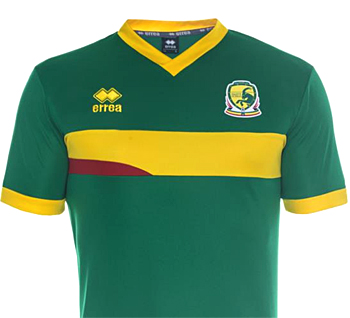 Ethiopia would defeat Lesotho away from home 2-1, courtesy of two more Getaneh Kebede goals, before finishing their campaign on a winning note, defeating Seychelles 2-1 at Awassa Stadium. Fears of political riots are believed to be the reason the game wasn’t held at Addis Ababa Stadium. A climate of fear had engulfed the country and after the deaths of hundreds of protesters across Ethiopia, football wasn’t really on the minds of people in the country. Nevertheless, Getaneh would score to take his AFCON qualifying tally to six, while a penalty kick from Salahdin Said sealed the three points. The games would see the debut of the Ethiopia national team’s new Errea jerseys. A deal signed with the Italian sportswear company sees Adidas replaced as the provider of Ethiopian national team sports apparel. Clad in their new kits, Ethiopia would finish the AFCON qualifying round robin tournament with three wins, two draws and a loss. Despite eleven points, the heavy defeat to Algeria meant that they were never going to better anyone via goal difference. Togo, also on eleven points would join Uganda in qualifying for the 2017 AFCON.
Ethiopia would defeat Lesotho away from home 2-1, courtesy of two more Getaneh Kebede goals, before finishing their campaign on a winning note, defeating Seychelles 2-1 at Awassa Stadium. Fears of political riots are believed to be the reason the game wasn’t held at Addis Ababa Stadium. A climate of fear had engulfed the country and after the deaths of hundreds of protesters across Ethiopia, football wasn’t really on the minds of people in the country. Nevertheless, Getaneh would score to take his AFCON qualifying tally to six, while a penalty kick from Salahdin Said sealed the three points. The games would see the debut of the Ethiopia national team’s new Errea jerseys. A deal signed with the Italian sportswear company sees Adidas replaced as the provider of Ethiopian national team sports apparel. Clad in their new kits, Ethiopia would finish the AFCON qualifying round robin tournament with three wins, two draws and a loss. Despite eleven points, the heavy defeat to Algeria meant that they were never going to better anyone via goal difference. Togo, also on eleven points would join Uganda in qualifying for the 2017 AFCON.
Had Ethiopia managed to defeat Seychelles away from home, instead of draw 1-1, the Walyas would have secured 13 points and booked their tickets to Gabon. Or had they held on against Algeria for another five minutes more at Addis Ababa stadium, they would have been aboard a plane for Libreville. So near yet so far, it irks the ardent Ethiopian football fan to know that self inflicted wounds probably ended up costing the country a return to the AFCON after four years.
With that, the Walyas signed off for 2016.
The offseason, which normally sees a flurry of activity including city and youth tournaments, saw football activity overshadowed by violence between protesters and the government.
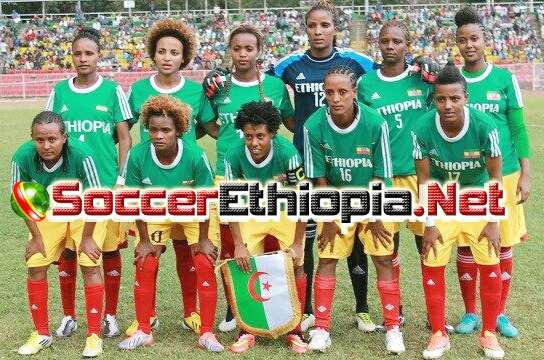 September saw the East African football governing body CECAFA reach a milestone in their managing to find the funds to hold the second CECAFA Women’s Cup, to be played three decades after the first one was held. Uganda hosted the tournament in which Lucy took part in. Lopsided score lines saw the 1986 champions Zanzibar concede thirty goals in three group stage games. But Ethiopia, coached by Meseret Manni, who made history as the first female coach to take charge of a men’s Ethiopian Premier League side a year earlier, managed to defeat Rwanda 3-2, courtesy of Meskerem Kanko and a Loza Abera brace before a goalless draw saw them reach the semi finals, safely navigating from their three team group. There, despite another Loza Abera brace, they would lose out to Kenya 3-2. In their first CECAFA Cup showing, Lucy would finish with the bronze medal, beating host nation Uganda 4-1, with Rehima Zergaw scoring a hat trick and Loza scoring once, her sixth goal for her country in 2016.
September saw the East African football governing body CECAFA reach a milestone in their managing to find the funds to hold the second CECAFA Women’s Cup, to be played three decades after the first one was held. Uganda hosted the tournament in which Lucy took part in. Lopsided score lines saw the 1986 champions Zanzibar concede thirty goals in three group stage games. But Ethiopia, coached by Meseret Manni, who made history as the first female coach to take charge of a men’s Ethiopian Premier League side a year earlier, managed to defeat Rwanda 3-2, courtesy of Meskerem Kanko and a Loza Abera brace before a goalless draw saw them reach the semi finals, safely navigating from their three team group. There, despite another Loza Abera brace, they would lose out to Kenya 3-2. In their first CECAFA Cup showing, Lucy would finish with the bronze medal, beating host nation Uganda 4-1, with Rehima Zergaw scoring a hat trick and Loza scoring once, her sixth goal for her country in 2016.
In October, Gebremedhin Haile’s short term contract as national team coach expired. The Ethiopian football federation hasn’t hired anyone since. They were said to have been close to making a decision on who would take the mantle, but the cancellation of the 2016 CECAFA Cup has given them ample time to delay the decision. Kenya, originally selected to host the tournament declared in November that they were unable to procure the funds and had to little time to organise the tournament. Further denting the credibility of the CECAFA organisation which has now had to call off two of the last three scheduled tournaments due to host nations refusing to own up to the responsibility at the last minute.
Had the CECAFA Cup gone on as preceded, Ethiopia who normally elects to send home based players to the tournament would have been able to count on the services of star strikers Getaneh Kebede and Salahdin Said, both of whom returned to the Ethiopian Premier League after stints with clubs in South Africa and Egypt respectively.
The Walyas took part in a measly eight internationals, winning only two of them, losing four and drawing two. Lucy didn’t fare significantly better, in their six matches, winning two, losing two and drawing two. All in all 2016 has seen a dip in the caliber of Ethiopian football.
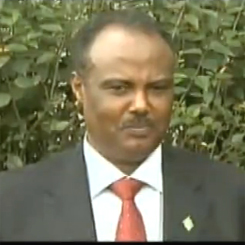 The Ethiopian football federation led by Juneidi Basha seems to have run out of ambition, with the selection of a coach and the drawing out of a blueprint for 2017 being placed on the back burner. The calendar year for the Walyas contains CHAN qualifiers, 2019 AFCON qualifiers and if the CECAFA management can secure a host nation, the 2017 CECAFA Cup. Yet the national team remains in limbo as it has been over the past four months.
The Ethiopian football federation led by Juneidi Basha seems to have run out of ambition, with the selection of a coach and the drawing out of a blueprint for 2017 being placed on the back burner. The calendar year for the Walyas contains CHAN qualifiers, 2019 AFCON qualifiers and if the CECAFA management can secure a host nation, the 2017 CECAFA Cup. Yet the national team remains in limbo as it has been over the past four months.
With the same lack of structural reforms, the same incompetent individuals running affairs, the contrast in desire and fervor of the country’s football officials and those of the fans, it is hard to be optimistic about the fortunes of Ethiopia’s national sides.
If anything, the Ethiopian national team’s new jersey design, which fans have criticized as looking dull, being uncreative and lacking pizzazz is in more ways than one representative of the current state of affairs. In the case of the Walyas, a new head coach must be hired as soon as possible if fans are going to see an unexpected swing of the pendulum. As it stands however, it remains idle, with the lack of effort to change the status quo.
Until then, which is the unforeseen future, the drift through the wilderness shall continue.
Author
Zecharias Zelalem is a regular contributor to Ethiosports. The opinions expressed here are those of the author and do not reflect the view of Ethiosports.




